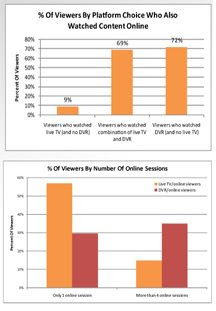
According to Brandweek, print is still losing its place as a viable business. National magazine spending fell 19.3 percent. Newspaper advertising fell 13.7 percent. But marketers who made those cuts didn't stop spending. Marketers migrated to digital media.
Still, the industry-wide advertisers only tell part of the story. Re/Max cut its print spending by 53 percent. Hertz Car Rental slashed 58 percent. State Farm dumped 55 percent of its print budget. Add to that Unilever's recent decision to double spending on digital marketing this year.
"I think you need to fish where the fish are," said Keith Weed, CMO for Unilever during a question-and-answer session with WPP Chief Executive Martin Sorrell. "So I've made it fairly clear that I'm driving Unilever to be at the leading edge of digital marketing."
According to an article by AdvertisingAge, Unilever is hardly alone. P&G doubled its measured U.S. Internet spending last year to $100 million.
The Case Against Migration.
Of course, not everyone is bullish on digital. Audrey Siegel, president at media agency TargetCast, who was quoted in the aforementioned Brandweek article, says dollar cuts aren't necessarily a shift from print to digital. She says print still commands the same amount of market share.
“In regard to digital spending, there’s no reliable source in tracking it, so when we talk about print dollars migrating, it’s anecdotal,” she said. “Digital will continue to grow but not necessarily just at the expense of print. It can just as easily be a case of broadcast dollars shifting into digital.”
Siegel seems to be be right and wrong. On one hand, print's hold over the same percentage of advertising spending is true. But on the other hand, it's not true for the reasons cited. Digital adverting has yet to make up ground as a viably priced medium. Specifically, digital media is still the cheaper buy while print, despite seeing publishing budgets shrink, are hanging on to higher ad rates.
The group trying to change all that isn't necessarily on the print publishing side. On the contrary, the Interactive Advertising Bureau is attempting to set some sort of standard that will place digital on equal footing. According to MediaWeek, the same problem remains. Everyone wants to plant "eyeball measurement" into the equation.
"Newspapers and magazines are particularly frustrated in their attempts to make up for steep print revenue losses with Web dollars and feel their high-quality content should command higher CPMs online," writes Lucia Moses. "Local newspapers have it tough because panel-based measurement isn’t well suited to local sites, resulting in erratic results."
One example Moses cites comes from Scripps. Scripps generates $500 annually per print reader but only $75 per online visitor. So the problem for many print publishers, to follow the marketing dollars online, is that "circulation" is up but the "value" of that circulation is down.
Solutions, solutions everywhere, and not even one to measure.
We see it every day. Many clients, even a few of our clients, are sometimes conflicted between the number of eyeballs versus engagement. It's a well-reasoned disconnect. Everything they have known until about five years ago suggests playing the numbers beats consumer concern. Every media salesperson on the planet has spoon fed them viewers, listeners, and readers as the fundamental measure of success. Public relations practitioners are guilty too, using the promise of reaching high circulation print pubs as their bread and butter has been the message they've carried forth for years.
The reality they are coming to terms with now is that "eyeball" rates do not necessarily equal conversation rates because two-way communication is a much different affair. Consider yesterday's research finding from Omni Hotels & Resorts as an example.
Seventy percent of those who do connect via Twitter and Facebook said that they share positive hotel experiences and incentives such as room upgrades. Sixty-two percent said they are more likely share positive experiences over negative ones.
So, in terms of "eyeballs," counting "followers" isn't the only answer. In some cases, ten followers might provide an expanded reach of 150,000 more people, assuming they share the content, page, incentive or offering. Add in their followers, and the potential reach could outpace some very respectable publications. However, not all of those potential eyeballs will ever equal conversions.
Case in point. One of our colleagues emailed us yesterday, excited by a traffic spike. When we asked them to attribute their spike, they said it became a controversial hot topic on a social network, meaning people disagreed whether the advice was wise or whether it was an advertisement.
"So, of all those people who flocked to the site to offer up their opinion," I queried. "How many will ever become customers?"
Hardly any. Contrary, the one follower who shared his post with ten friends within proximity to his business — those people, especially if they make plans together — are very likely to become customers. The irony, however, is that marketers have been trained to devalue the qualitative for the quantitative for their entire careers and it's just not true.
That's right. That video with one million views might be worthless. The one with ten views, depending on the value of the customer, might be worth $1 million. And the only way to approach media buys right now is to know the difference and find the middle. But since each middle might be different, there is no "formula" as much as there is an equation that leaves many publishers out of the loop.


















